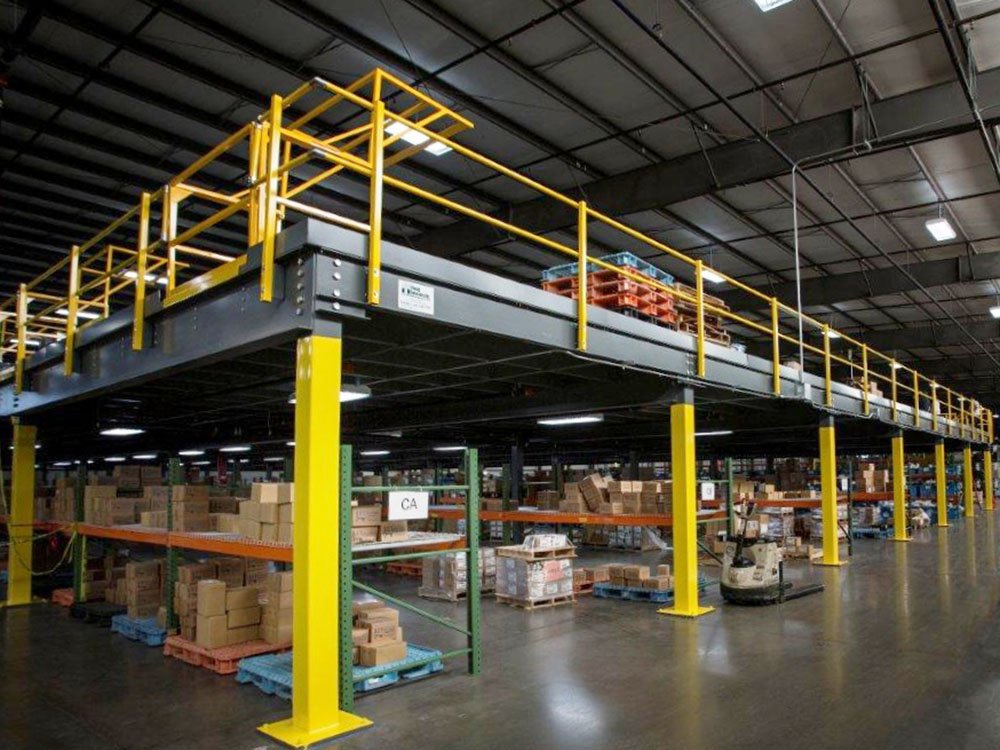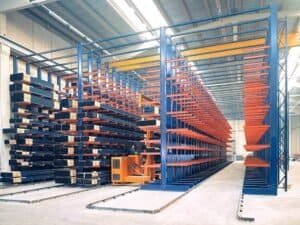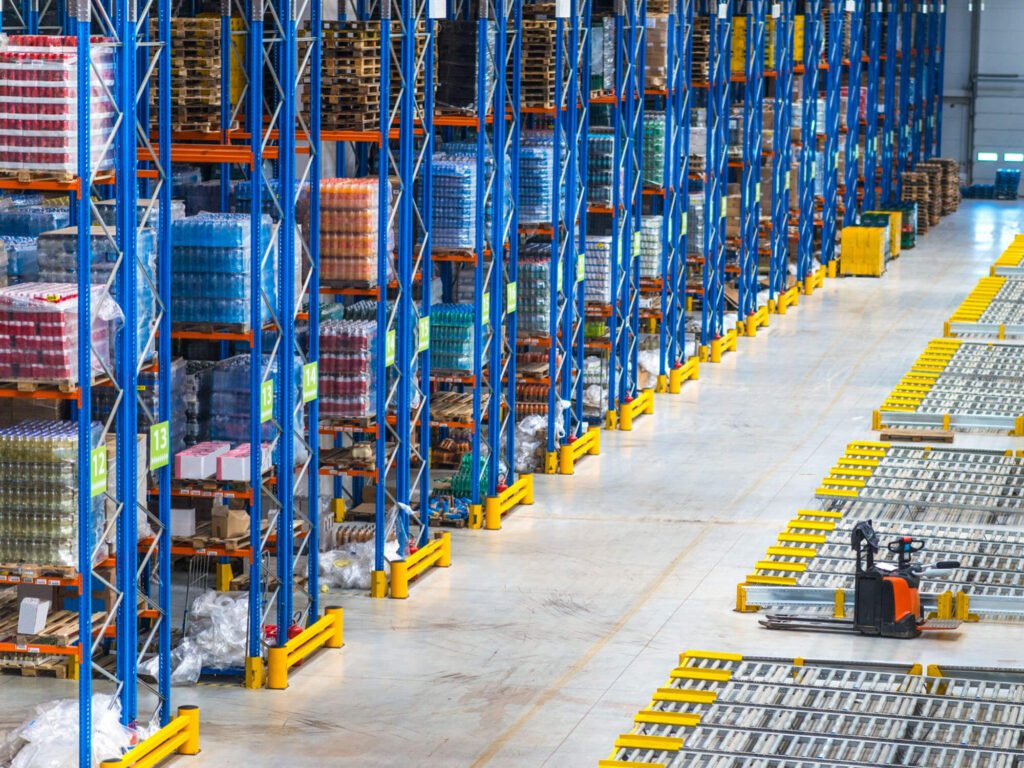The business demand for additional storage, office, and production spaces becomes inevitable with growth. However, the expenses for adding extensions, acquiring a new space, or relocating can significantly exceed the budget. Warehouse mezzanines come in here.
A warehouse mezzanine is a space-saving structure that allows businesses to utilize vertical space by transforming unused overhead areas into valuable space. This article explores the key benefits, various mezzanine types, and common applications of warehouse mezzanines. In addition, the guide explores key considerations for mezzanine design, safety, installation, and maintenance.
Regardless of your industry, how a mezzanine can optimize space, improve storage, and enhance efficiency is key to scaling warehouse operations.
What Is a Warehouse Mezzanine?
A warehouse mezzanine is a space-conserving structure that utilizes the vertical space in a building by installing an elevated platform. The mezzanine is installed between the floor and ceiling, providing extra vertical space in the warehouse.
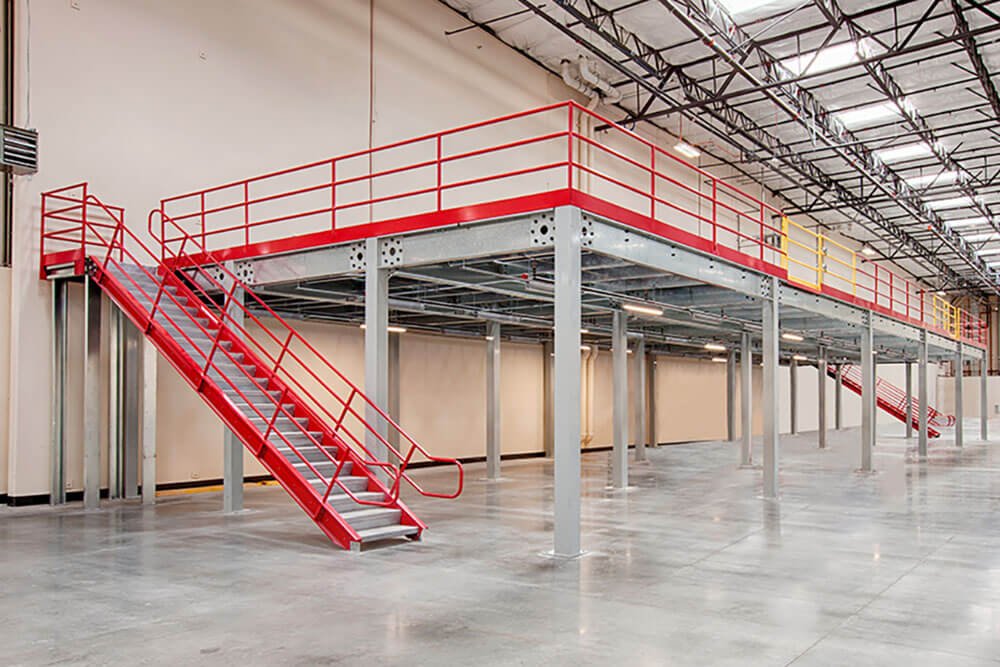
Types of Warehouse Mezzanines
Structural Steel Mezzanines
A structural steel mezzanine is also referred to as a steel mezzanine floor. As the name implies, this type of warehouse mezzanine is steel-based, and its most important feature is its fully assembled structure.
This gives the structural steel mezzanine design flexibility along with certain capabilities as opposed to general storage equipment. Because of its load-bearing capacity, structural steel mezzanine can be used for warehouse offices or equipment, hardware and electronic product storage.
Rack-Supported Mezzanines
The rack-supported warehouse racking mezzanine consists of two main parts (the mezzanine floor and the adjustable racks). This racking system places an intermediate mezzanine floor on existing pallet racks or workplaces to increase storage space for more goods. The rack-supported mezzanine is applied across many industries, such as auto parts, light, electronics, clothing warehousing and more.
Modular Mezzanines
Modular mezzanines are prefabricated, adjustable systems designed for flexibility. They can be easily reconfigured or expanded to accommodate changing warehouse needs, making them ideal for businesses expecting growth or fluctuating inventory levels. Their quick installation and adaptability help businesses remain agile.
Shelf-Supported Mezzanines
Shelf-supported mezzanines utilize existing shelving units as structural support, making them ideal for storing smaller, lightweight inventory. They maximize vertical space and are best suited for industries like retail and e-commerce that need organized, easily accessible storage for small items.
Benefits of Installing a Warehouse Mezzanine
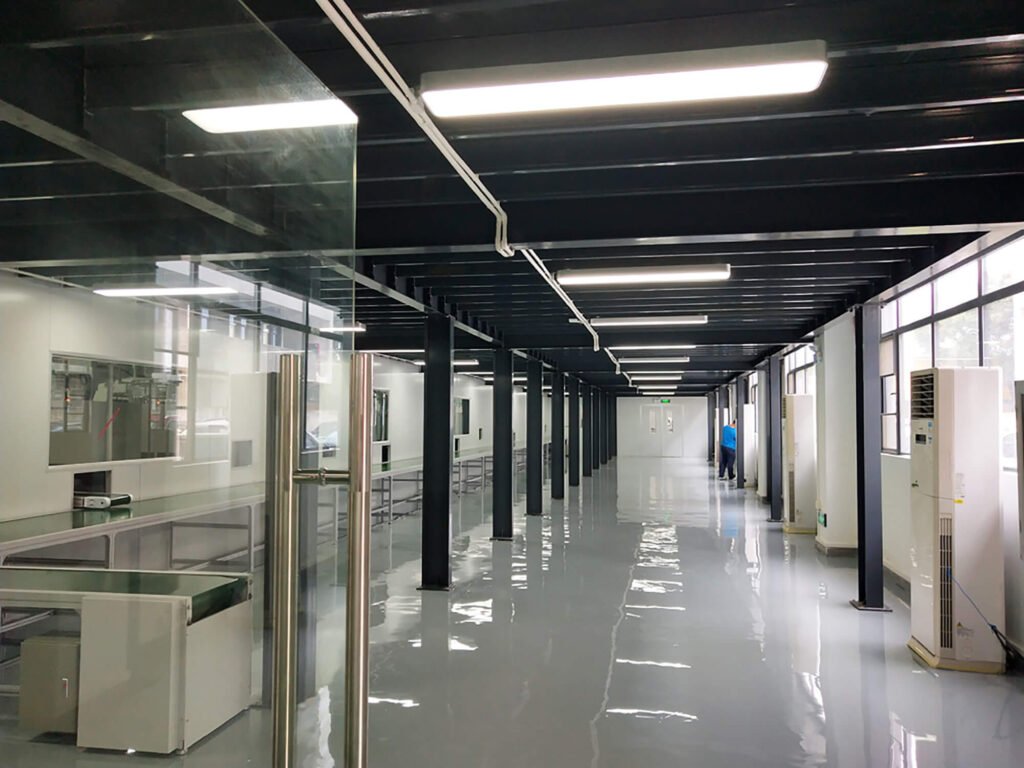
Space Optimization
The major benefit of warehouse mezzanines is their ability to create more space and optimize existing space through vertical expansion.
Cost-Effectiveness
Warehouses requiring extra space can save the expansion used in building extensions or relocate by installing mezzanines. With this approach, warehouses can convert space they already own into new usable sections for storage or work.
Improved Workflow and Efficiency
Strategically placed mezzanines can even improve workflow and efficiency of warehouse operations and enhance inventory management. For instance, a warehouse can install rack-supported mezzanines to store more inventory vertically instead of extending.
Flexibility and Scalability
Quickly growing businesses need warehouses that are flexible and scalable, and mezzanines are one solution. For example, structural steel warehouse mezzanines come in fully assembled flexible structures for numerous design patterns. In addition, small warehouse mezzanines can be fixed and decoupled as needed without major structural changes to the entire building.
Key Considerations for Warehouse Mezzanine Design and Planning
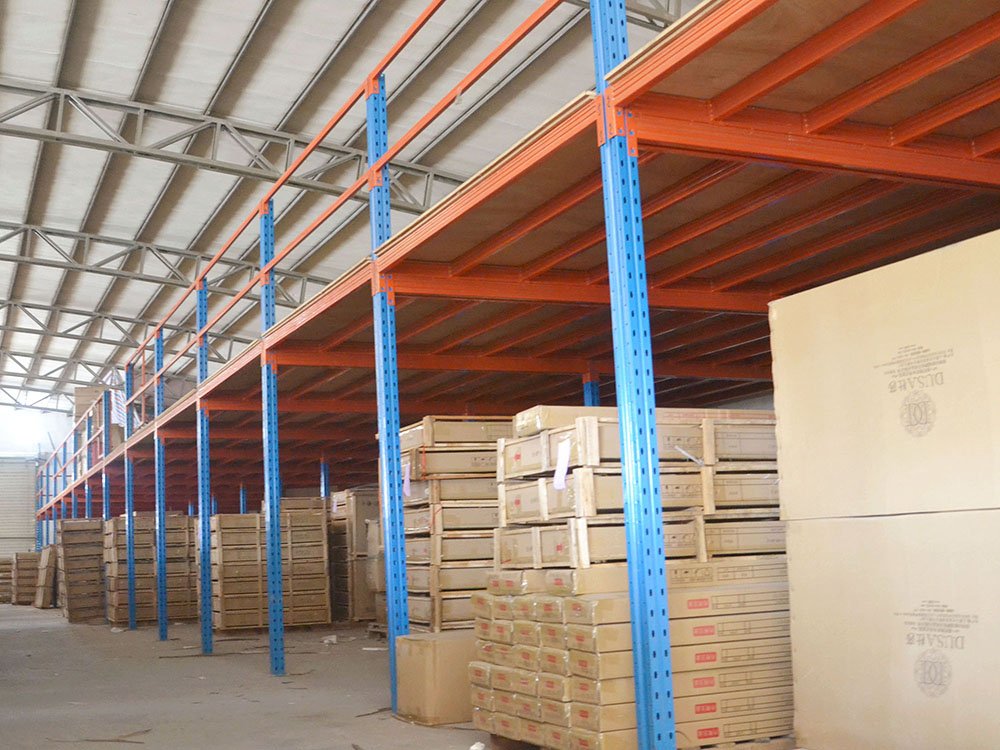
Load Capacity and Weight Distribution
To avoid structural failure and loss of property and lives, warehouses must consider the mezzanine’s load capacity and weight distribution. The load capacity determines how much load or weight the warehouse mezzanine can carry. Weight distribution deals with how the weight should be spread across the mezzanine platform.
Warehouse Layout and Space Availability
Integrating a mezzanine can significantly impact the warehouse operation, making it a key consideration during planning.
Access and Safety Features
Safety is a major concern in warehouses where employees work with heavy-duty equipment. While planning, the business must discuss safety in the new construction and options, such as stairs, handrails, guardrails, and safety gates.
Compliance with Building Codes and Regulations
The newly proposed mezzanine structure must comply with the local building codes and regulations. These building regulations set a safety standard to protect lives and property.
Lighting, Ventilation, and Fire Safety
When integrating electrical installations like HVAC systems and lighting, there should be adequate space for maintenance, repair, and emergencies. The safety implications should be considered while providing easy access to all sides of the installation.
Fire emergencies are common in warehouses stocked with electronics and flammable materials. So when designing and planning for a warehouse mezzanine, installation of fire sprinklers and provision of fire exits are important.
Installation Process Warehouse Mezzanine: What to Expect:
Initial Site Survey and Measurement
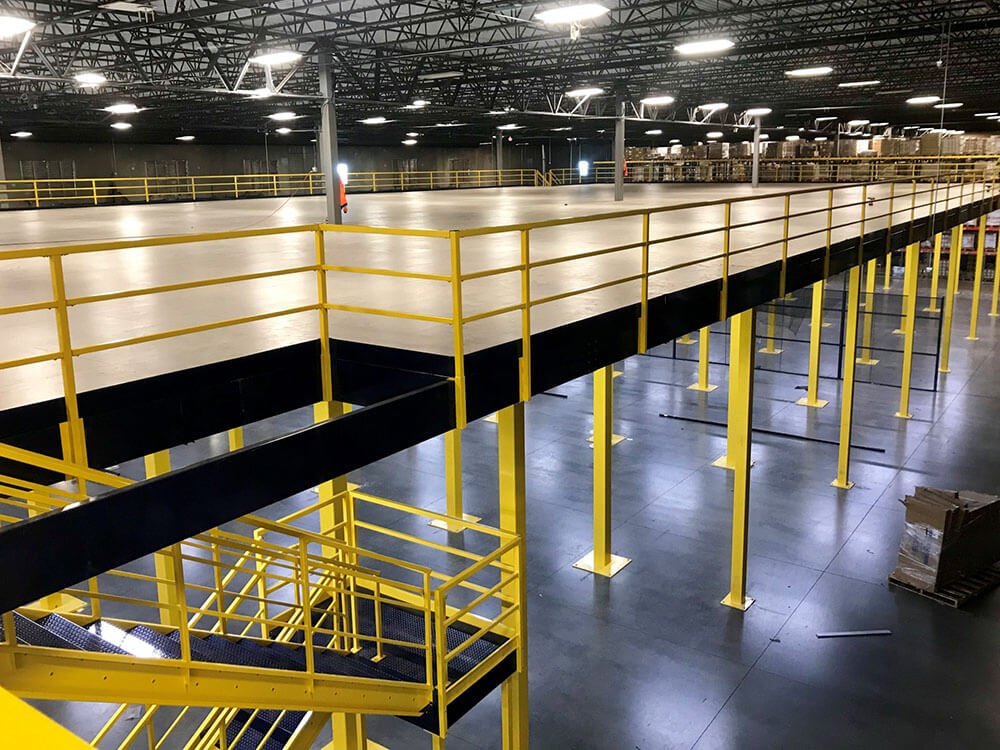
Before purchasing the equipment and hiring contractors, an initial site survey is performed, and measurements of the building are taken. This is to assess designated spaces for the warehouse mezzanine, the layout design, and the structural requirements.
Warehouses that skip site surveys and measurements are bound to encounter development problems. They may even run the risk of building structures that are not scalable or pose a threat to lives and property.
Design and Customization
The design and customization of a warehouse mezzanine depend primarily on the business’s needs. The process begins with understanding the mezzanine’s purpose and then accounting for factors like load capacity, space (vertical and horizontal), and workflow requirements.
Because of future expansions and reconfigurations due to business growth, the structural flexibility of the mezzanine is also crucial. The warehouse mezzanine customizations include the materials, shelving systems, and attachments. Consider also how the mezzanine integrates with existing warehouse equipment, such as forklifts or conveyors.
Permitting and Compliance
Before diving into the construction, businesses must secure the necessary permits from local authorities. The building codes provide a framework for ensuring safety and structural integrity when installing the mezzanine structure.
Using these permits, an engineer may have to assess the mezzanine’s load-bearing capacity and the materials used in construction. Non-compliance could result in costly delays or penalties.
Installation Timeline and Process
Site inspection and preparation are the first steps in installing a warehouse mezzanine. The area is cleared, and constructors ensure foundational structures are ready for mezzanine support. The time to assemble the warehouse mezzanine varies based on the structure’s size and complexity.
While some disruptions to warehouse operations are inevitable, careful planning can help minimize downtime. To remedy this, constructors may schedule installation during off-peak hours or in phases to allow continued operations.
Post-Installation Inspection
Post-installation inspection is a necessary step to ascertain the structural integrity and safety of the new warehouse mezzanine. In addition, a final inspection should be done to ensure the structure complies with the building code.
Warehouse Mezzanine Safety: Essential Guidelines

Weight Limits and Load Distribution
The most important tip is never exceeding the specified load capacity. Even when the load capacity is under the specified capacity, it must be evenly distributed to avoid concentration in one area. The impact of moving/shifting loads should also be carefully considered.
Remember that floors have their carrying capacity, meaning they may be unable to support heavy loads even if the pallet racks can. Have inspectors regularly check the mezzanine structure to identify problems and areas for maintenance.
Proper Use of Safety Features
Work-related accidents contribute significantly to global mortality rates. The good news is mezzanine accidents can be prevented with proper guidelines and employee training for using handrails, safety gates, and fall protection.
Regular Inspections and Maintenance
The management must regularly inspect the warehouse mezzanine structure to spot any wear, damage, or potential safety hazards. The inspections also check how the load distributes and the structure load capacity over time as the structure ages.
Employee Training
It’s necessary to train employees on using the warehouse mezzanine and safety protocols to know what to do if they are in problematic situations. The training can reduce employee mistakes when interacting and the chances of accidents during a hazard.
Best Practices for Maximizing Warehouse Mezzanine Use
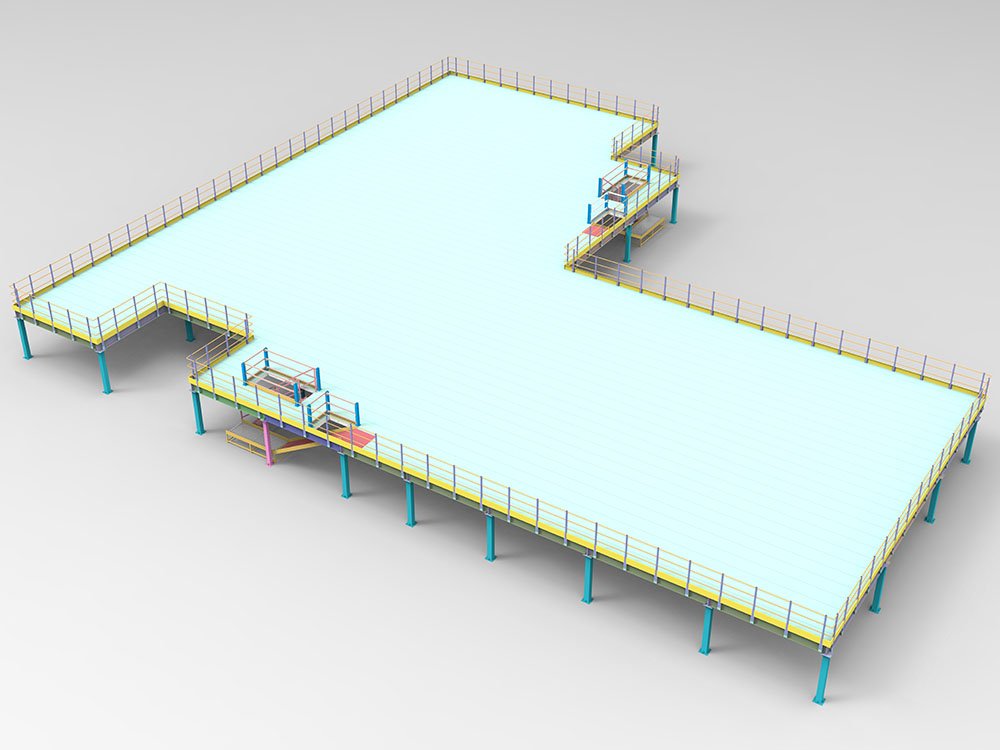
Optimizing Storage Layout
Optimizing storage layout will allow businesses to get the most value from their warehouse mezzanine. By simply arranging shelves and racks in a way that facilitates easy access, the warehouse can maintain optimal workflow and reduce accidents.
In addition, the weight balance should be considered to determine the most efficient locations for storing equipment on the mezzanine. The effort into carefully planning the layout can significantly reduce time spent retrieving inventory while boosting operational efficiency.
Integrating Mezzanines with Other Warehouse Systems
The functionality of mezzanines can be significantly enhanced by integrating regular warehouse systems. For example, conveyor belts and vertical lifts can allow for quick movements of goods between the mezzanine structure and ground levels.
Meanwhile, pallet jacks can facilitate the quick movement of goods on the mezzanine floor. These integrations not only reduce manual labour but also increase operational efficiency.
Adjustable and Modular Designs
Modular mezzanine structures provide flexibility and scalability for growing businesses or those anticipating inventory changes. These mezzanine types are made adjustable to allow for easy expansion and reconfiguration without needing major structural changes.
In the future, additional mezzanine levels or extensions can be added to accommodate more inventory or new equipment. The scalability of modular designs ensures businesses can avoid the high costs of constructing new facilities or relocation. Moreover, modular mezzanine can minimize operational disruptions during upgrades or expansion.
Warehouse Mezzanine Maintenance and Long-Term Care
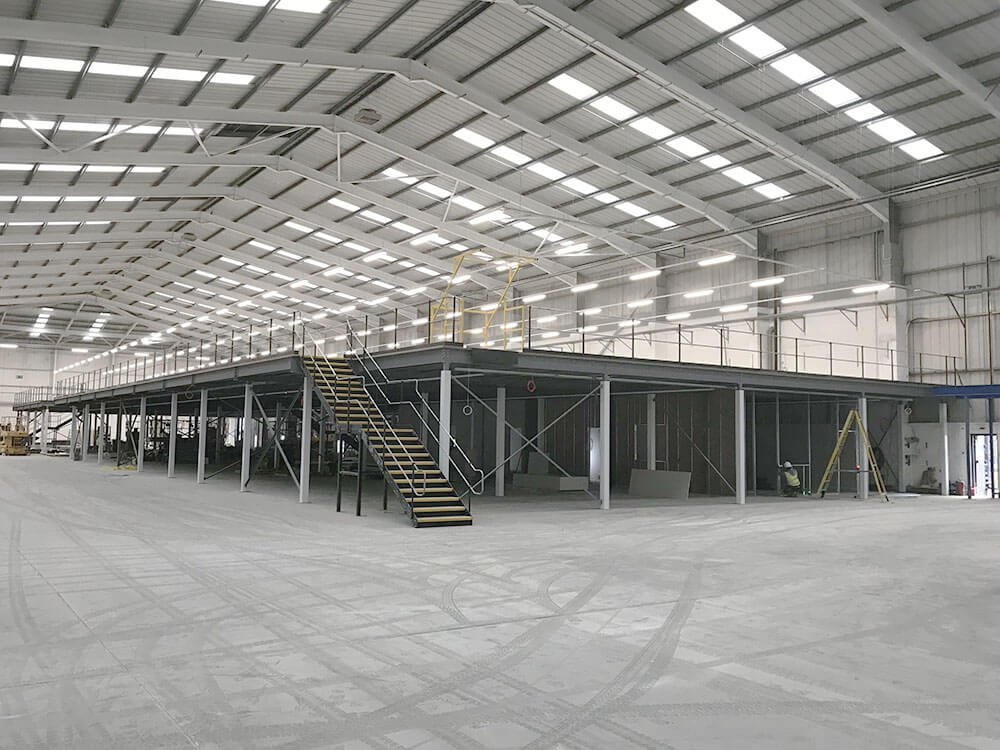
Regular Inspections
As mentioned earlier, regular inspections are a must. However, the frequency of these inspections matters as much. Warehouses must carry out scheduled monthly, quarterly, and annual inspections of the mezzanine structure to ensure its safety.
In addition, inspections help the warehouses stay ahead of issues such as wear and damage through regular maintenance.
Addressing Repairs and Upgrades
It’s natural for certain mezzanine components to experience wear or damage as time goes by. However, it is crucial to address repairs as soon as they arise. Some common repairs include replacing rusted bolts, reinforcing weakened beams, or fixing damaged decking.
In addition, regular upgrades should be considered to increase the lifespan of the warehouse mezzanine as the material evolves. For example, warehouses can switch to higher-grade steel or install enhanced safety features. Furthermore, upgrading equipment like conveyor systems or lifts can improve operational efficiency.
Compliance Checks
Building codes are subject to updates, meaning regulations can change, and warehouses must effectively comply. So, the management should perform regular compliance checks during inspections, repairs, and upgrades.
Conclusion
The warehouse mezzanine guide should be a reference point for businesses looking to utilize more space and improve operational efficiency. The article explores the types, benefits, key considerations, installation, safety, and maintenance. However, this guide is only an overview, and businesses must consult an expert for proper assessment of integrating warehouse mezzanine. Lracking not only offers expert consultancy but also supplies state-of-the-art warehouse mezzanine for all business operations. Contact us today to learn about tailored solutions and warehouse mezzanine prices for your business.

